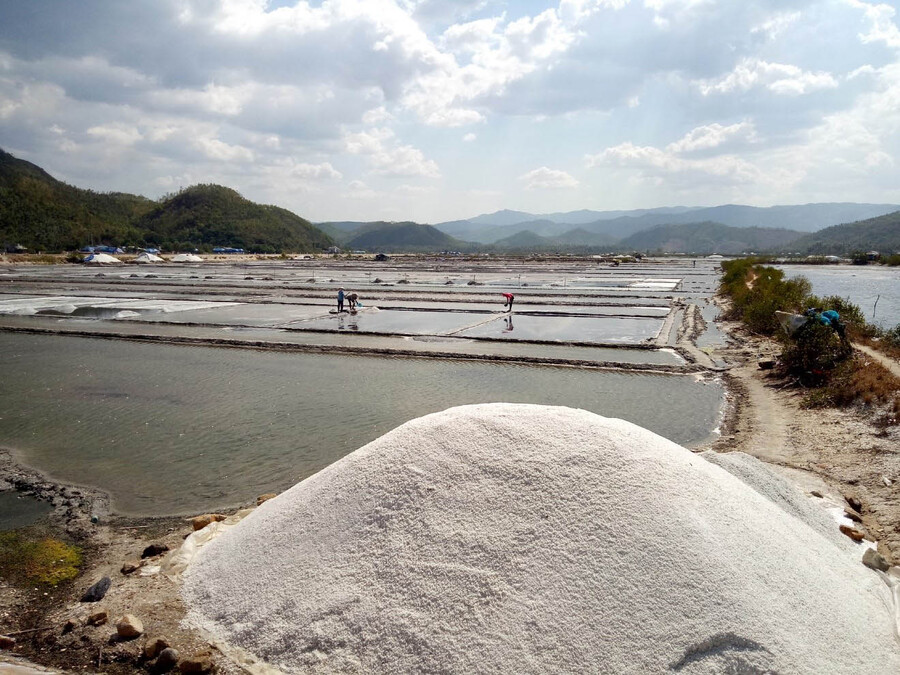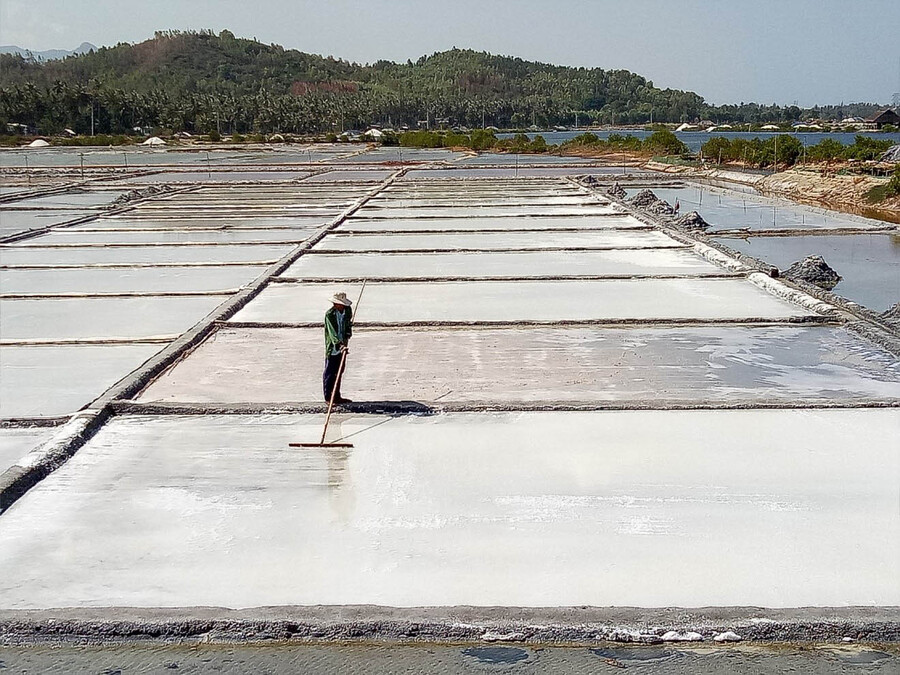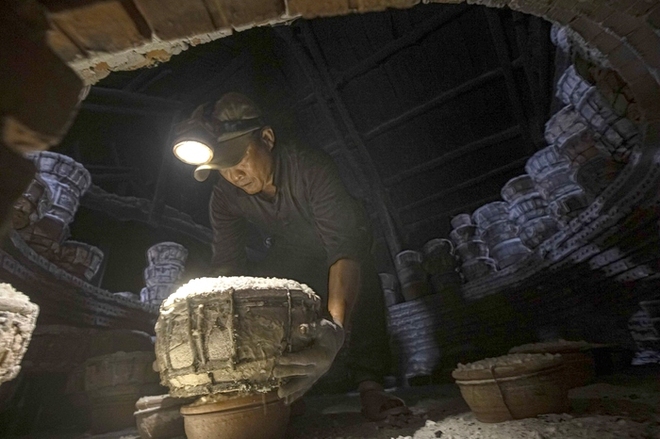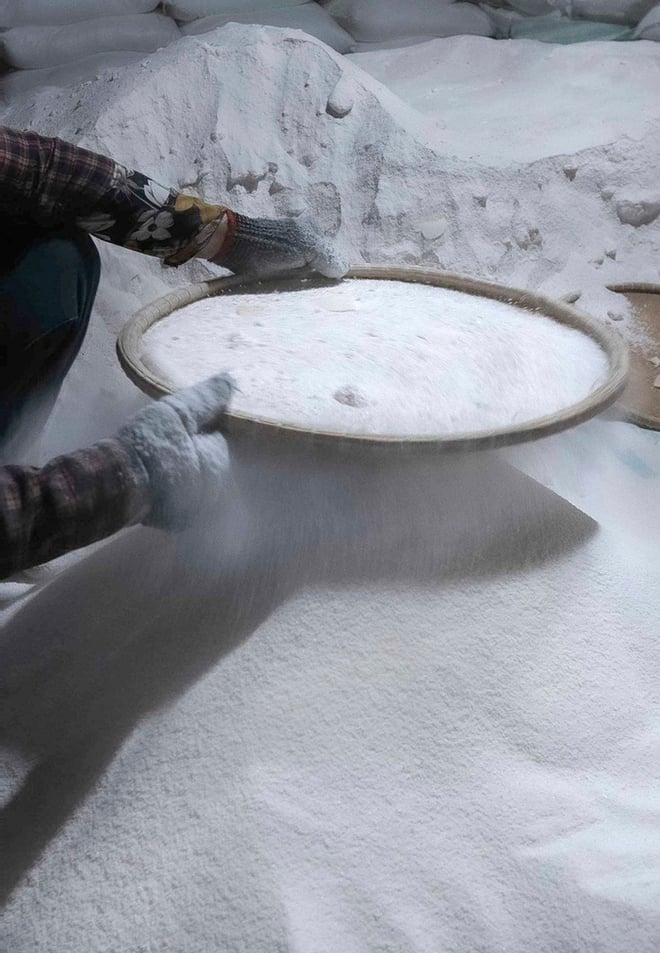This craft village is not only famous for its snow-white salt grains, but also for the stories of the hard work, hardship, and love for the homeland of the simple salt workers.
The name "Tuyet Diem" evokes the image of pure white salt grains, sparkling under the golden sunlight like snowflakes in a vast field.

Tuyet Diem salt making creates a beautiful and impressive picture of labor in Song Cau town. You can admire the giant salt mounds under the bright sunny sky. Photo: Manh Hoai Nam
The village name not only symbolizes the color of the salt but also speaks to the excellent quality of the salt produced here. "Diem" in Sino-Vietnamese also means salt, combined with "Tuyet" to honor the purity and high value of Tuyet Diem salt.
However, to get those pure white salt grains, the people here have gone through many hardships. They do not stop at just getting salt from the salt fields but also have to go through an elaborate processing process to create the special salt that only Tuyet Diem has.
History of formation and difficulties of Tuyet Diem salt industry
Tuyet Diem salt field has existed for more than 150 years, since 1870, but unlike other famous salt fields such as Sa Huynh, Ca Na or Hon Khoi, this salt field has never been fully planned. The salt fields are still fragmented and uneven, causing salt farmers to face many difficulties in the production process.
During the French colonial period, Tuyet Diem salt was so valuable that the French authorities had to build large warehouses to store and guard it carefully.
A familiar saying in the village at that time was "Cu Mong salt costs thirty dong per grain," reflecting the value of salt here during that period.
The name "Cu Mong salt" also comes from the special geographical location of Tuyet Diem village, located right at the foot of Cu Mong pass.
Ships from the South to the North, when arriving at Tuyet Diem, head towards the foot of this pass, where there is the only salt field in Phu Yen . This prime location has contributed to the brand of Cu Mong salt - a type of salt with firm, pure white grains, rich but not harsh salty taste.
For many years, Tuyet Diem people have maintained the traditional method of producing salt by hand. They bring seawater into the ground plots, leave them in the sun for 4-5 days until the salt crystallizes.
This job requires a lot of patience and hard work. Once the salt has crystallized, the salt workers continue to rake the salt into rows and carry it to the collection site.

The salt fields stretch across endless fields, with mountains in the distance creating a beautiful landscape. Photo: Manh Hoai Nam
It is worth mentioning that people here are still attached to the salt making profession not only for economic reasons, but also because this is a traditional profession, a spiritual heritage passed down from their ancestors.
Although it is hard work, in each grain of salt they create is a wholehearted devotion, a pride that is not easy to give up.
Among the products made from Tuyet Diem salt, salt mine is considered the most valuable specialty. Currently, the whole village has only 4 households maintaining the profession of making salt mine with an output of about 10 tons per day.
The process of making salt cellar is very elaborate and time-consuming. After being harvested, the salt grains will be brought to the warehouse to begin the salt cellar process.
The salt mine is a circular, open-air brick kiln with a simple but effective structure. At midnight, workers start loading salt grains into the kiln and cook continuously for 24 hours.
During this process, the miner must regularly shovel charcoal to cover the surface of the furnace to ensure even heat.

Salt is filled in the kiln, then the worker lights the firewood, starting the salt cellaring process. Photo: Thai Ba-na
Once the salt is ripe, it is left to cool before female workers use their hands to sift out the fragrant, fine salt powder – a unique specialty that only Tuyet Diem has.
Tuyet Diem Salt and the path to the world
Although it is a traditional product, Tuyet Diem salt is not only consumed domestically but also exported to Cambodia as a raw material for salting fish, making fish sauce and producing dried products.
This proves that the value of Tuyet Diem salt has been affirmed not only in the domestic market but also in the international market.
Nowadays, as Tuyet Diem salt village is becoming more and more known through photos, articles and stories, many tourists have come here to witness the hard working life of salt workers.
Every drop of sweat falling on the salt fields, every quiet step on the small path in the middle of the vast salt sea, all depict an emotional picture of human love and love for the land.

Salt harvested from the salt fields will be put into ceramic pots to be put into the furnace. Photo: Thai Ba-na
Amidst the difficulties and challenges, love and pride in the salt industry are always the strong bond between Tuyet Diem people and their homeland. It is an inseparable bond, a love that is difficult for anyone to fully understand if they have not lived and experienced the long days on Tuyet Diem salt fields.

Sifting salt is the final step. Thanks to the stewing process, Tuyet Diem salt is smooth, has a moderate salty taste, and is not bitter. Photo: Thai Ba-na
Tuyet Diem salt village is not only a place to produce snow-white salt grains, but also a symbol of the perseverance, love for the profession and love for the homeland of the people here. They have been maintaining and promoting traditional values, so that Tuyet Diem salt grains are not only a product, but also a part of the soul of the countryside, of memories and of pride in the homeland.
Source: https://danviet.vn/mot-lang-dac-biet-duoi-chan-deo-cu-mong-phu-yen-dan-lam-ra-loai-muoi-my-mieu-tuyet-diem-20210909225518151.htm
























































































![[Infographic] In 2025, 47 products will achieve national OCOP](https://vphoto.vietnam.vn/thumb/402x226/vietnam/resource/IMAGE/2025/7/16/5d672398b0744db3ab920e05db8e5b7d)














Comment (0)